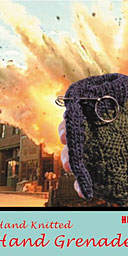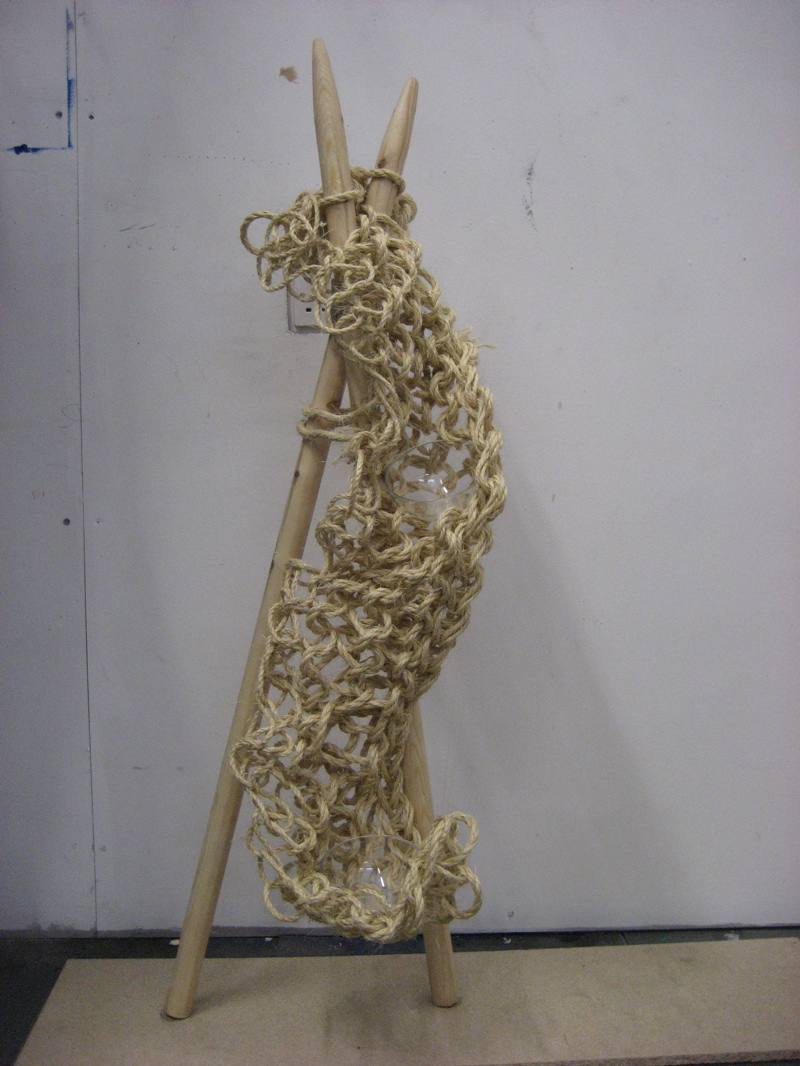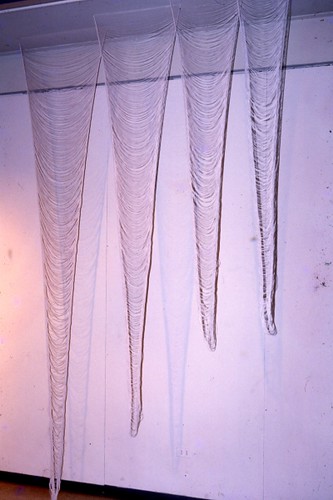
Friday, 14 May 2010
Thursday, 13 May 2010
Tuesday, 11 May 2010
Synopsis
SYNOPSIS
The aims I wish to investigate are broken down into three chapters, each addressing a different topic that I wish to investigate in detail. The titles of these chapters are likely to change slightly as my research and ideas develop, however the content of the chapters will be the same, just different wording of the titles. The first chapter is titled “What is knit”, in this chapter I aim to investigate the historical background of knitwear, as well as looking at knitwear at present and discussing how it has changed and advanced. Another key point I would like to look into in this chapter is how knitwear has become fashionable.
I will be researching various knitwear designers, past and present to try and develop and understanding of when this change took place and knitwear was considered fashionable. From looking at different collections I will be able to see the changes that have occurred, how knit is becoming more and more advanced, and what can be achieved through the use of different techniques, machines, and fabrics.
Another sub topic I am considering for this chapter is hand vs. machine, looking into the advantages and disadvantages (if any), and comparing the two to see what can be created. I feel this will help support the advances of knitwear. Much of the early knitwear was created by hand, so the use of different machines will show how the use of technology has played a key role in the advances of knitwear. This will be supported by visual images.
This first chapter will also investigate the contextual side and show why this topic is relevant now, looking at various knitwear collections could help support this by showing what is being achieved now, and the success of many upcoming knitwear designers. I feel this is a very relevant topic to look at, in the past few years there has been many new and successful knitwear designers which seem to be playing a key role in fashion and trends.
The second chapter will investigate the link between knit and art. Fashion designers are continuing to push the boundaries of fashion and knitwear, garments are beginning to look more like amazing art sculptures than garments to be worn. From my research so far I have found designers using different materials and fabrics to knit with, creating amazing sculptural pieces. Knit art seems to be something that is becoming more common, I have found a range of different artists who use knit as a medium, and create knit installations. I will be visiting Pitti Filati, a knit trade show in Florence, to back up this investigation and gain some really interesting information and images to help support the dissertation.
The third chapter will investigate the future potential of knitwear, breaking down the future for knitwear, looking at what has previously been discovered and what knitwear can go on to create for the future.
My research strategy has begun in searching for various related articles, images which support my areas of investigation. I have created a blog to keep a record of all my research; I will continually be updating this, with new research. I find this is a valuable way of documenting as it allows others to give feedback and each entry is dated, so it will show my development. I have begun to search for relevant books and have planned a visit to the British library and the V&A library.
I have planned visit to Florence in July to attend Pitti Filati a knit trade show, and another knit and stitch show in October. I feel these visits will be very beneficial and I hope to gain a lot of important and insightful information especially for chapters 2 and 3 which are the main arguments in my dissertation. Pitti Filati will feature upcoming trends which will consist of new innovative knits, a wide range of knitters/designers and artists showcase their work there so it will be a great opportunity to build contacts for interviews. New fabrics and yarns will also be shown which will contribute to my research on what can be created/new technologies. The knit and stitch show will showcase knitted garments, knit art and gradate work.
My preliminary research seems to be heading in the right direction; I have found a number of very interesting artists and designers that I will be using as case studies. For example the work of knitwear designer Sandra Backlund with her amazing sculptural knits and Craig Lawrence with his innovative use of different materials used to knit with. As well as my two primary research visit’s I plan to visit the V&A archives and look at the knit section to see if there is anything of interest which I could investigate in my first chapter. I have looked online and found a list of collections/albums which may be of interest however I do not want to rely on these as a main primary source as I am not sure what I will find. The artefacts listed range from 1918- the mid 90’s, so hopefully there should be some of interest. I think it is important to look into the history of knit, although I do not want to look too far back in great detail, just to gain and insight, to strengthen my other topics.
I plan to interview a few knit artists and designers I feel are doing new and interesting things with knit, such a Sandra Backlund and Craig Lawrence. I have currently not found any newspaper articles which I find relevant to my topics of investigation, this will take further time to find, however I have the majority of all other research sources planned, so this is not such a large issue at present.
The main issues arising for my research so far are the relationship between fashion and art, what can and has been achieved in knit. The new technologies that influence the advances in knit, and the change that has happened in knitwear to consider it fashionable.
My dissertation will be written, with relevant visuals to support it. I decided to choose this subject as I am very passionate about knitwear and how it has become modernized and plays a big part in fashion now. It’s so inspiring to see so many designers doing such interesting things with knit, I feel there is so much that can be created with knit, and find it a very interesting topic. Studying knit and having worked in the industry on placements I continue to find the possibilities that knit has to offer more and more exciting, through new fabrics or technology.
 A look into some collections from 2000, from L to R, Chanel, Jean Paul gaultier, Sonia rykiel.
A look into some collections from 2000, from L to R, Chanel, Jean Paul gaultier, Sonia rykiel.
Knitwear collections from 2010 L to R Pringle,Mark Fast, Cooperative Designs, Derek Lawlor.
Major difference in knitwear over a decade
Knitwear in fasion
A new generation of fashion designers who are pushing the boundaries have reinvented the art
Books of interest
Knitwear in Fashion. Sandy Black
Knitting technology: a comprehensive handbook and practical guide. David J. Spencer
For the Love of Knitting: A Celebration of the Knitter's Art. Kari A. Cornell, Melanie Falick p 149
Knitting Art: 150 Innovative Works from 18 Contemporary Artists Karen Searle
Contemporary knitting for textile artists
Shibori Knits: The Art of Exquisite Felted Knits Gina Wilde
Primary Research Sources
Knitting and stitch show 7-10 October
V&A archives
Chapter ideas, (titles need developing)
- What is knitwear?
A possible sub topic of hand vs machine.
- The link between Fashion and Art
- Future potential of Knitwear
A breakdown of the future of knitwear, new technologies
Monday, 10 May 2010
.jpg)
.jpg)
“The Cactus, The Bear, and The Mountain” is not a children book, it`s an ecological knitwear collection
Tine Winther Rysgaard and Trine Kristoffersen for the for Innovating Sustainable Fashion Competition 2009.
 How to make a piece of work when you’re too tired to make decisions by Freddie Robins, 2004
How to make a piece of work when you’re too tired to make decisions by Freddie Robins, 2004 In The Beginning Was The Word by Stephanie Speight, 2000.
In The Beginning Was The Word by Stephanie Speight, 2000.Stephanie Speight has used the fettuccine attachment of her pasta machine to shred old books and produce a chunky recycled paper yarn which she has handknitted.
http://www.culture24.org.uk/art/craft/art27959
Political protest turns to the radical art of knitting

Once a devalued craft, knitting is now taking on capitalism, consumerism and war.
Needles are flying: the guerrilla knitters are here.
An exhibition at the Crafts Council Gallery in London next month will show that knitting - long belittled as the preserve of elderly ladies declining towards senility - has become a politically engaged, radical artform.
One artist constructs intricate, two-metre-high knitted panels based on prostitutes' calling cards. Another knits balaclavas and photographs people wearing them around New York. There is even a group of activists that stages knit-ins on the London Underground, occupying a carriage and knitting around the Circle line.























